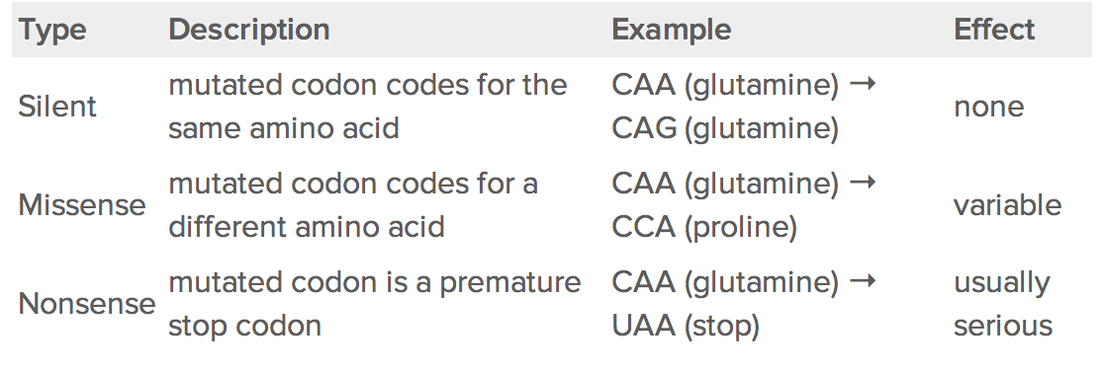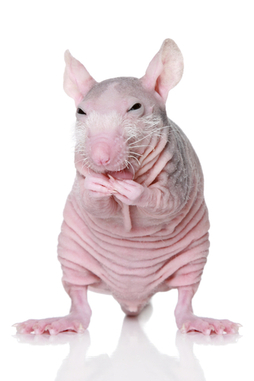Unit 5: Protein Synthesis / MutationsCentral Dogma of protein synthesisDNA → RNA → Proteins
Transcription Translation TranscriptionHow does a cell use the information in its DNA?
To transcribe means "to paraphrase or summarize in writing." The information in DNA is transcribed - or summarized - into a smaller version - RNA - that can be used by the cell. This process is called transcription. Transcription The process in which cells make proteins is called protein synthesis. It actually consists of two processes: transcription and translation. Transcription takes place in the nucleus. It uses DNA as a template to make an RNA molecule. RNA then leaves the nucleus and goes to a ribosome in the cytoplasm, where translation occurs. Translation reads the genetic code in mRNA and makes a protein. Transcription is the first part of the central dogma of molecular biology: DNA → RNA. It is the transfer of genetic instructions in DNA to messenger RNA (mRNA). During transcription, a strand of mRNA is made that is complementary to a strand of DNA. Figure below shows how this occurs. You can watch an animation of the process at this link:http://www.biostudio.com/d_%20Transcription.htm.
TranslationRNA to proteins. How?
You must translate. To go from one language to another. Spanish to English, French to German, or nucleotides to amino acids. Which type is the translation of molecular biology? Obviously, the type of translating discussed here translates from the language of nucleotides to the language of amino acids. Translation Translation is the second part of the central dogma of molecular biology: RNA → Protein. It is the process in which the genetic code in mRNA is read, one codon at a time, to make a protein. Figure below shows how this happens. After mRNA leaves the nucleus, it moves to a ribosome, which consists of rRNA and proteins. The ribosome reads the sequence of codons in mRNA. Molecules of tRNA bring amino acids to the ribosome in the correct sequence. What causes albinism?

This rare albino alligator must have the specific "instructions," or DNA, to have this quality. The cause of albinism is a mutation in a gene for melanin, a protein found in skin and eyes. Such a mutation may result in no melanin production at all or a significant decline in the amount of melanin.
Mutations
A change in the sequence of bases in DNA or RNA is called a mutation. Does the word mutation make you think of science fiction and bug-eyed monsters? Think again. Everyone has mutations. In fact, most people have dozens or even hundreds of mutations in their DNA. Mutations are essential for evolution to occur. They are the ultimate source of all new genetic material - new alleles - in a species. Although most mutations have no effect on the organisms in which they occur, some mutations are beneficial. Even harmful mutations rarely cause drastic changes in organisms. POINT MUTATIONS A point mutation is a change in a single nucleotide in DNA. This type of mutation is usually less serious than a chromosomal alteration. An example of a point mutation is a mutation that changes the codon UUU to the codon UCU. Point mutations can be silent, missense, or nonsense mutations, as shown in Table below. The effects of point mutations depend on how they change the genetic code. You can watch an animation about nonsense mutations at this link FRAMESHIFT MUTATIONS
A frameshift mutation is a deletion or insertion of one or more nucleotides that changes the reading frame of the base sequence. Deletions remove nucleotides, and insertions add nucleotides. Consider the following sequence of bases in RNA: AUG-AAU-ACG-GCU = start-asparagine-threonine-alanine Now, assume an insertion occurs in this sequence. Let’s say an A nucleotide is inserted after the start codon AUG: AUG-AAA-UAC-GGC-U = start-lysine-tyrosine-glycine Even though the rest of the sequence is unchanged, this insertion changes the reading frame and thus all of the codons that follow it. As this example shows, a frameshift mutation can dramatically change how the codons in mRNA are read. This can have a drastic effect on the protein product. BBC Knowledge Explainer DNA from Territory on Vimeo. |
Protein synthesisFiles:
Helpful linksProtein synthesishow mRNA creates a protein
Transcription & Translation
DNA, RNA and proteins
A Look into the cellsee how proteins are made and used
Mutations | ||||||





